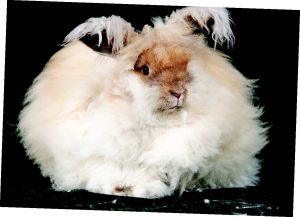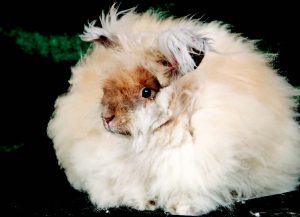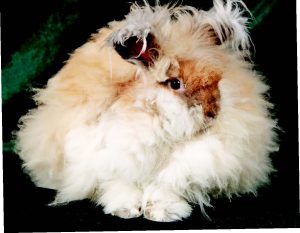Rabbits come in all shapes and sizes. But if anything, the Angora rabbit has most of those rabbits beat with their sheer size. Their amount of fluff is unmistakable and is a major factor in the cuteness points for this rabbit.
Angora rabbits are, of course, more than just their fur. And thanks to the Philippine Lapine Club Inc., who were kind enough to give Animal Scene an interview, we now know more about the Angora rabbit.
Q: First of all, Angora rabbits are fairly new to the Philippines. How and when did the breed come here? As opposed to other breeds, how rare is it in the Philippines?
Philippine Lapine Club Inc. (PLCI): The EnglishAngora came to the Philippines through importation from breeders in the rabbit industry in 2015. Only a few breeders and hobbyists have this…breed [including] a few members of the Philippine Lapine Club Inc. as well as other rabbit clubs in the country.
Q: How did you become fascinated with it? What are the appeal points of the Angora rabbit that most rabbit hobbyists mention?
PLCI: The Angora is a very distinct breed because of the fur they possess, when compared to other breeds. When posed properly, their compact body and uniform wall of wool gives the appearance of a round ball. A very fluffy ball.
Q: What consists of an Angora rabbit’s diet?

PLCI: Like any other rabbit: unlimited hay, water, and some greens and pellets that are intended for rabbits are what its diet is composed of.
Q: Angora rabbits look quite large. Are they actually very large or is it an illusion from all the fur? Is an average Angora heavy or does it just look that way from all the fur?
PLCI: There are four types of Angoras: English, French, Satin, and Giant. Angoras look quite large due to their fur but they actually weigh five to ten pounds only and are not as heavy as they look.
Q: Angora rabbits are known for their large amounts of fur, are there any special considerations when it comes to grooming? How badly does it shed, if at all?
PLCI: Since Angoras have a large amount of fur, daily grooming is required. Brushes, a hair blower, and/or a vacuum, and a pair of scissors—to cut stubborn matted fur—are the best tools to use in keeping an Angora’s fur clean and mat-free. Depending on the Angora type and the weather, shedding or molting varies.
Q: What is its personality like? How often can or should they be handled by humans? Are they recommended for children?
PLCI: Like any other prey animal, rabbits can get easily scared when handled at first. But once they are used to it, they can be held without any problem. Angoras have a grouchy personality but that can be changed with proper care and bonding. Because Angoras require extra care with regards to grooming their fur, which can get easily matter, we do not recommend this breed [for] children.
Q: What are the signs that an Angora is rabbit is healthy and happy? What are the indicators that it’s sick?
PLCI: Healthy and happy rabbits should have bright and bold eyes, healthy teeth with no sign of malocclusion (any slight form of misalignment of the teeth), the fur is flyback or rollback, and it’s not bony. Because rabbits are prey animals, they do not show any symptoms if they are sick, except for some diseases that show clinical signs.
Q: If someone were to consider owning an Angora rabbit, what tips are needed by a first time owner? Any words of advice for anyone who might be interested in owning one?
PLCI: To anyone who [considers] owning a rabbit, research is the best thing that should be done before getting one. A group like ours, the Philippine Lapine Club Inc., is composed of experienced breeders, enthusiasts, and rabbit lovers who can help an individual learn about rabbits, from basic care and breeding to clarifying myths and superstitions about rabbits. Any individual who would like to have an Angora rabbit should keep in mind that grooming is the biggest chore
RABBITY FACTY 1
Contrary to the popular belief that the Angora came from Europe, the Angora rabbit actually originated from—you guessed it—Angora, which is now called “Ankara” in Turkey. The European misconception comes from the fact that in the mid-18th century, some members of Frenchroyalty kept them as pets. And also the fact that Angora rabbits were imported into the Americas around the early 20th century from Europe.
RABBITY FACTY 2
Angora rabbits are known most especially for their fur. All it takes is a bit of posing and grooming, and you can get a perfect puff ball. Aside from being an animal that hobbyists like to keep as pets and showcase, they are also bred for the long wool they produce. Angora wool is said to be seven times warmer than sheep’s wool but its texture is too fine to be held together via knitting. Blending the fiber with others, such as sheep’s wool, silk, or cashmere, can keep it together.
RABBITY FACTY 3
Giving your Angora rabbit access to unlimited hay and water is incredibly important. This is important, especially when feeding hay can help prevent wool block, otherwise known as a hairball.
If feeding hay is too boring (and maybe your rabbit will get bored too) you can add some greens in as well. Offer up some dark leafy greens as opposed to the pale green types. For example, you can feed your Angora rabbit alfalfa, basil, cilantro, and broccoli leaves. Offer up a minimum of at least three different types. Again, it can get boring with just one type so some variety is good.
If rabbit pellets are more your style for feeding, then that is totally okay. When it comes to feeding rabbit pellets, it varies among the different types. English Angoras require one-third cup twice a day while the French, Satin, and Giant Angoras require a half cup of pellets twice a day.
Don’t forget—your rabbit needs a constant supply of fresh water.
RABBITY FACTY 4
From the four types of Angoras, the most common type of rabbit that hobbyists in the country own, according to the PLCI, is the English Angora. Actually, even outside the country, the English Angora is the most common type found among hobbyists and breeders. That is because the English Angora is the smallest type out of the four and weighs up to a maximum of seven and half pounds. And the biggest type of Angora rabbit is, of course, the Giant Angora, which weighs in at at least nine and a half to ten pounds.
RABBITY FACTY 5
With the considerations for grooming an Angora, imagine a salon but for rabbits—that is the kind of grooming you will need for your rabbit. The Angora comes with a massive cloud of fur and with that massive cloud comes massive responsibility. It is also very handy to have a pair of dedicated scissors or shears for your Angora because no matter how much care a person puts in, an Angora rabbit’s fur will sometimes become matted. For those moments, you will definitely need to start snipping at your rabbit’s fur to keep it mat free.
RABBITY FACTY 6
Based on the fact that Angora rabbits are still, you know, rabbits, they are just like any other prey animal in that you need to be able to handle them carefully. A “handle with care package,” if you will. And, in contrast with its appearance, it is not exactly a ball of sunshine. Their grouchy personality can change to be more open to their owners. Maybe then they will become the balls of sunshine they seem destined to be.
And because an Angora rabbit’s fur can easily get matted and having to cut off the fur from any child-related accidents would mean having to actually give the rabbit a full haircut, it’s best not to have children handle it. Don’t want it to lose the perfect ball shape from a mishap, after all.
This appeared in Animal Scene magazine’s March 2018 issue.






